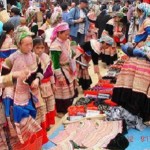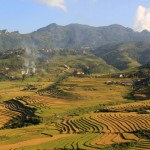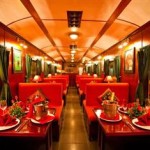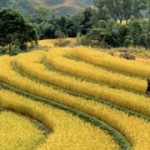Sapa markets
Bac Ha Market
Bac Ha market is well-known for its naturally sub-tropical scenery. Tam Hoa plums are really a local specialty: sweet and fresh. This seems to be created by its own land, people and nature. Average temperature here is 19°C and it’s not so cold as in Sa Pa. Bac Ha is specifically identified by each mount, each house and naturally-made carpet of white plum-flowers in spring. There are 14 ethnic minorities and the Mong ethnics count for 47% then the Dao, Tay, Nung, Phu La… Mountaineers take care of their horses as their properties, means of transport and close friends. Besides plums, Bac Ha is reputed for its alcohol (made of maize). Maize is grown on high mountains, its low in productivity but high in nutrition. To make alcohol, it’s fermented with Hong My seed (the local only plant). Bac Ha alcohol is well-known due to its source of water. So it’s surely believed never to have faulted one in Bac Ha market. Mong or Tay or Dao ethnics’ minority girls and boys, with their best dresses on, go to the market to relax and meet their friends. At sunset, they leave with a promise to see again. Visitors to Bac Ha are opportune to understand the local traditions and customs, taste local specialties, meet nice people and know a land code-named: white plateau.
Coc Ly Market
It is the colorful market in a mountainous area where the Flower H’mong mainly gathers to exchange their homemade products.This Tuesday market is about 35km from Bac Ha. You can get here via a fairly good road, or by road and river; hotels in Sapa and Bac Ha can organise trips. Coc ly is a small village on the Chay river inhabited by the Flower H’mong Minority people. The Flower H’mong traditionally wear a distinctive and bright coloured costume. They are a gentle, softly spoken people who live in the steep mountainous country close to the Chinese border. Because Coc Ly is more remote than Sapa, the dress and way of life is more traditional than in the large centers. The market deals in fruit, vegetable, pork and chickens, in addition to colourful fabrics and items of traditional dress. There is a buffalo sale in progress and many of these placid animals are tethered close to the market. Buffalo are still widely used in the growing process, especially in the mountainous regions.
Can Cau Market
Cancau market is one of Vietnam‘s most fascinating open –air market, and isolated market which takes place only on Saturday every week.
This is a lovely local market which still retains the local quaint and authentic
being of the main tourist route.
The areas is close to China border and in a hidden place, less visitors come here. – Horses, dogs, cat, pigs and textiles…. all on sales! This is of most amazing market you’ve ever seen. Opportunity to takes best photos
Sapa Love Market
Sapa is also famous for its love market, which takes place on saturday evenings. The love market of Sapa used to be the place to find a partner to get married. With the tourism, the real love market does not take place anymore. Currently you can only see a representation of the love market. Do not miss it anyway if you are staying here a saturday night.Young Red Dzao hill tribe used to come to Sapa to sing songs to the opposite sex. Girls sang the songs hidden in the dark, when a boy found them, and if they matched together, they disappeared into the forest for three days. Some of them got married after that.
Muong Khuong Market
Big market with a wide range of ethnic groups: Hmong, Dao, Nung, and merchants from other ethnic groups who come all the way from China to sell their products. Several Pa Zi women sell traditional incense made from the bark and resin of scented trees.
Muong Khuong market takes place on Sundays and is located in a small border town, which is frequented by Flower Hmong, Tu Di, Tay and Giay ethnic minorities. They come from surrounding villages to buy and sell local products such as food and material for agriculture and fabric.
Lung khau Nhin Market
Taking place every Thursday, Lung Khau Nhin Market is a small market hiding itself among the mountains and forests of the far north Vietnam about 10 km from the border with China. Although not being so big or famous among visitors as Coc Ly and Can Cau, Lung Khau Nhin market, be side a normal shopping place, play an important role to spiritual life of local ethnic peoples Flower H’mong, Black Zao, Zay, and especially to those who come from very small ethnic groups such as Pa Zi, Tou Zi, Tou Lao who live in small and isolated villages around this corner of the country, come for meeting, socializing…
Binh Lu- Tam Duong Market
Binh Lu market & Tam Duong market opened every sunday.
Binh Lu and Tam Duong market is located on the other side of Sapa, passing the 1900 meter Tram Ton pass, Viet Nam’s highest mountain pass and considered the most beautiful stretch of road in the country.
The town is bustling with activity as the local hill tribes gather for their weekly market day, amazing tribal markets in Binh Lu where thousand of Thai Kadai language groups such as Tai Lu, Tai Laos, White Tai, and H’mong – Yao group (black Yao, Yao Lantien..) Giay, Khomu.. comes to buy and sell their own produces.
Every Sunday from 8 am to 1 pm.
The road trip here takes about 3 hours from Lao Cai (127km) and 1 and a half hours from Sapa (90Km).
Pha Long Market
Very rural seldom visited market, where you can meet ethnic groups that are only found in this particular district of Vietnam, mostly Hmong, Nung, Tou Zi, Pa Zi and Tou Lao. Along the road, in a landscape of mountain peaks, numerous Nung et Hmong villages. Lots of traditional houses with baked earth tiled roofs.
Pha Long market, Saturday morning from 6 a.m. to twelve.
Cao Son Market
Location: The road trip here takes about 2 and a half hours from Lao Cai (75km) and 3 and a half hours from Sapa(115Km)
Most the participants are Flower H’mong, Black Zao, Nung, Tu Di, Pa Di ethnic form villages in the surrounding region but many come from China to add more colors to the market. Cheerful and smiling faces are everywhere at the market place and the peoples behave like close friends meeting again after long time away. It is easy to realize women from different groups through traditional costumes they wear while men’s dress are similar.
Per week for just one session meeting on Wednesday, at the market session, right from early morning, individuals or groups of ethnic minorities come to Cao Son Market.
Muong Hum Market
Muong Hum located in Bat Xat district, about 50km far from Laocai. Muong Hum Market is set on open flat land at the bottom of a large and scenic valley by a small river and surrounded by terraced rice paddies. It is often empty and quiet on the other weekday, waken up and busy on Sunday. This market is well-known as one of the most interesting Sunday market in Lao Cai province and possibly a good alternative trip to Bac Ha market for visitors thanks to the very large variety of the ethnic minority peoples to attend and quite easy to be distinguished through their traditional clothes.
Si Ma Cai Market
Location: Simacai is 27km from Bac Ha, 98km from Lao Cai City and 135km from Sapa
Si Ma Cai is not as frequented as Bac Ha or Sa Pa, also located in the mountainous province, since it is nestled at the far end of a road near the border with China. Traveling there requires visitors to hold onto their hats and their seats either in a car or on a motorcycle for nearly 40 kilometers of bumpy, winding road from Bac Ha.
Mountain adventurers like to compare Si Ma Cai in the northern mountainous province of Lao Cai to a shy lass with discrete charms sleeping in the mountain as the beauty of the little-known village lies in the quiet and simple daily lives of different peoples.
Xin Cheng Market
Xin Cheng market opens on every Wednesdays. It offers the opportunity to discover a colorful gathering point of many local minorities (Flower Hmong, Tay or Giay).
On the way to the Bac Ha market along the Chinese border, you will enjoy amazing mountain scenery, charming rivers and terraced rice fields. People from vicinities meet at the market to exchange tobacco, clothes, fruits, horses, buffaloes and many other local products. Xin Cheng is also a social gathering point for the villagers to meet and exchange the latest news.
On the way back to Sapa, you will pass by the Hmong King Palace which was built in the early 20th century during the French colonial era.








